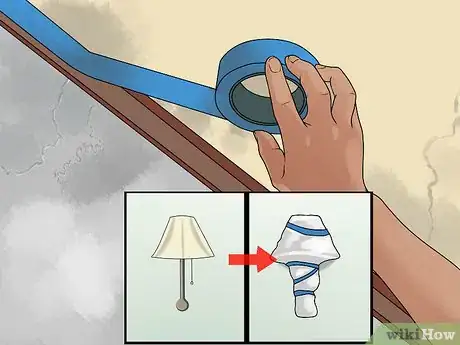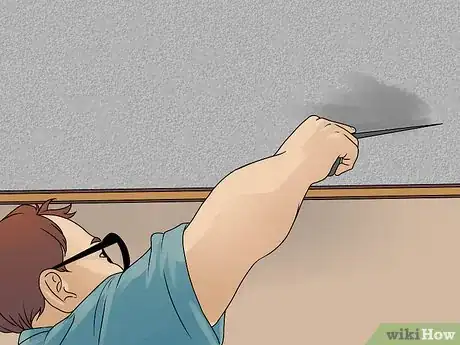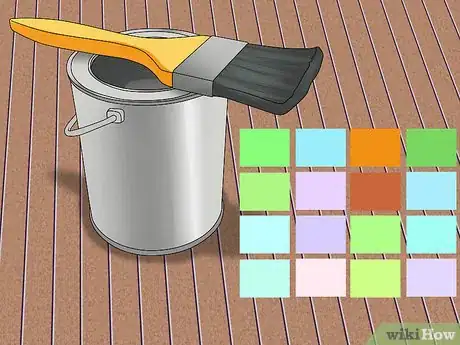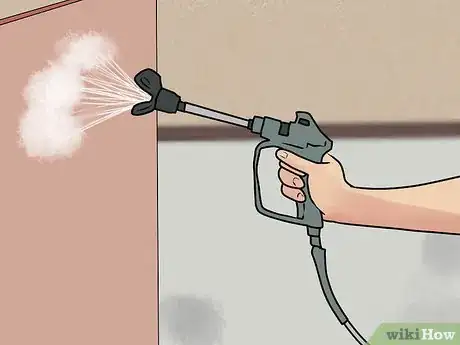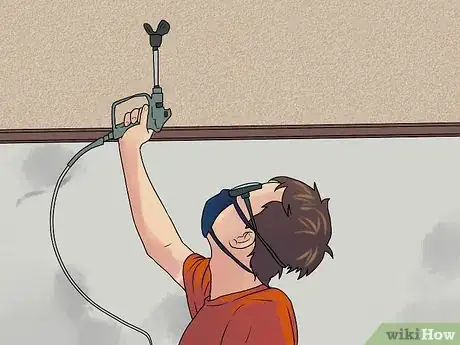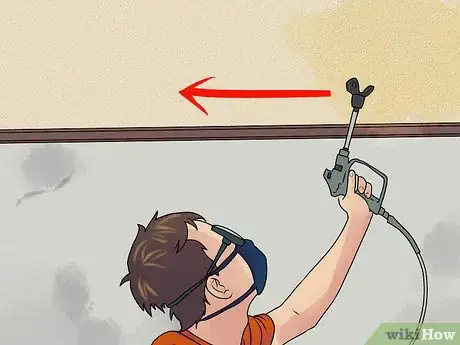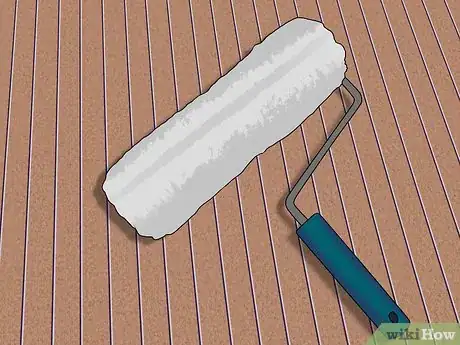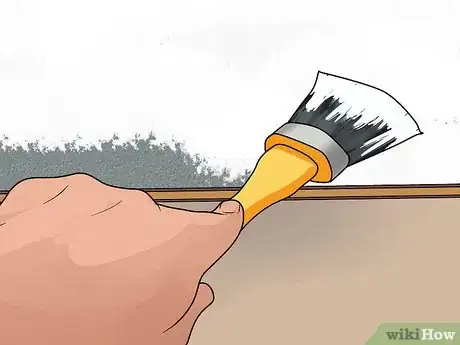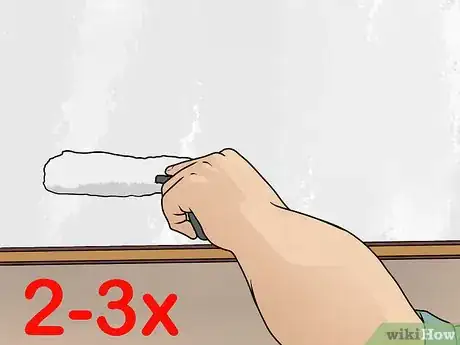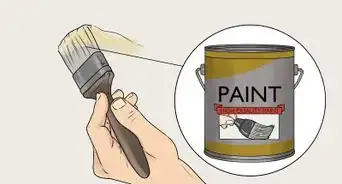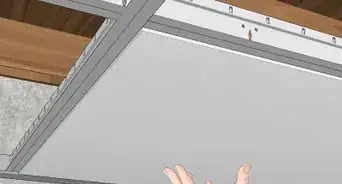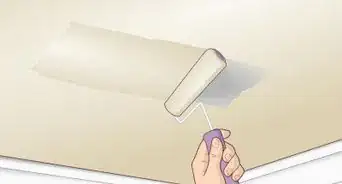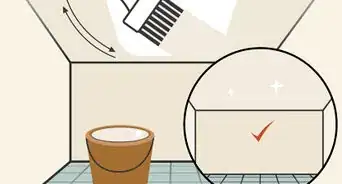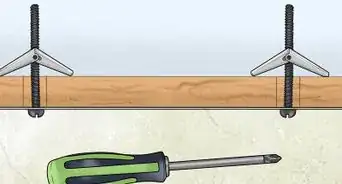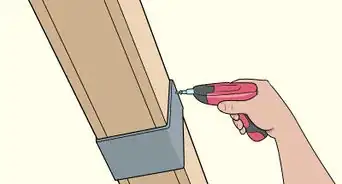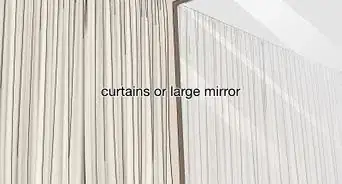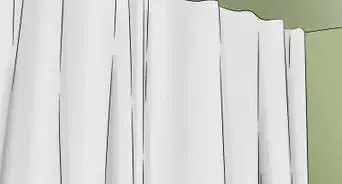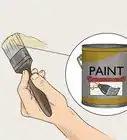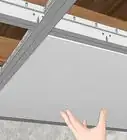This article was co-authored by Patrick Coye. Patrick Coye is the owner and operator of Patrick’s Painting & Home Improvement in Alexandria, Virginia. With over 15 years of experience in residential construction, Patrick specializes in painting, wallpaper removal/installation, drywall, staining decks and fences, and kitchen cabinetry painting. To date, Patrick and his team have painted over 2,000 houses and stained over 800 decks. Patrick's Company won a "Top Job" award from the American Painting contractor magazine in 2020.
There are 8 references cited in this article, which can be found at the bottom of the page.
wikiHow marks an article as reader-approved once it receives enough positive feedback. In this case, 98% of readers who voted found the article helpful, earning it our reader-approved status.
This article has been viewed 223,307 times.
Painting the ceiling is an inexpensive way to brighten up a room. If you have popcorn ceiling, though, the texture may make you think twice about painting. However, if you prepare in the right way and know the proper techniques for painting a textured ceiling, it's a fairly easy home improvement project. That means you can have your popcorn, or acoustical, ceiling looking like new in no time.
Steps
Preparing the Room
-
1Test the ceiling’s water solubility. To figure out the best way to paint a popcorn ceiling, you need to know if it’s ever been painted before. A popcorn ceilings that hasn’t been painted previously is usually water-soluble. If you paint it with a roller, the ceiling may absorb moisture from the paint and the texture can come off on the roller. Test your ceiling’s water solubility by spraying a small, unnoticeable spot with water. If the area becomes soft, your ceiling hasn’t been painted before.[1]
- If your ceiling hasn’t been painted before, the best way to paint it is with a spray gun.
-
2Remove and cover the furniture. Painting an overhead surface means that there can sometimes be drips, so you need to protect the furnishings in the room. Take as much of the furniture out of the room as possible. If there are large, difficult to move items, cover them with drop cloths or plastic sheeting to keep the paint off them.[2]
- Don’t forget to place drop cloths or plastic on the floor too.[3]
Advertisement -
3Use painter’s tape and plastic to cover fixtures and walls. If possible, it’s best to remove light fixtures before you paint the ceiling. However, if you can’t, make sure to wrap them completely in masking paper and painter’s tape.[4] You’ll also need to cover the walls, including windows, fans, vents, and doors, with plastic sheeting. Be sure to make an extremely tight seal at the point where the ceiling meets the wall with painter’s tape.[5]
- If you’re painting the walls along with the ceiling, you obviously don’t have to worry about covering them and creating a seal with paint. You still need to cover the fixtures, windows, doors, and baseboards, though.
- A tight seal is especially important if you’re planning to spray the ceiling. You can go with a looser seal when you’re rolling on the paint.
-
4Have the right safety gear. Before you move on to making ceiling repairs or painting the ceiling, make sure that you have the proper safety equipment to protect yourself. When you’re working on an overhead surface, it’s easy for debris, paint, and other materials to fall in your face. Always wear a dust mask and safety eye mask or glasses.[6]
- It’s also a good idea to wear a hat to cover you head. You’ll also want to make sure that you’re wearing old clothing or disposable coveralls that you don’t mind ruining.
-
5Make any necessary ceiling repairs. Once the room is covered in plastic, it’s important to fix any damage to the ceiling before you start painting. For small areas that require repair, you can use a can of spray acoustic texture. For larger areas, you’ll likely need to use powder texture that mixes with water and apply with a pneumatic hopper. [7]
- Spray acoustic texture works best on areas of damage that are 16-inches by 16-inches or less.
- If your ceiling has never been painted before, you can remove damaged areas by applying water to them and scraping away the damage.[8]
- Make sure to seal any areas of water damage with an oil-based, stain blocking primer that’s been thinned with water by approximately 25 percent.
- When you’re checking the ceiling for damage, keep an eye out for dust, dirt, and other debris. Use a feather duster to remove it.
Getting the Paint Ready
-
1Choose the right finish. When you’re painting a popcorn ceiling, paint with a flat or matte finish is usually the best option because it won’t draw attention to any areas with uneven texture. However, if you prefer a satin or semi-gloss finish, you can usually use those without any problem.[9]
- If the ceiling is in a room that is prone to humidity, such as a bathroom or kitchen, a satin or semi-gloss finish paint is actually the best option.
- Try to use as high quality a paint as you can afford. The better the paint, the less you’ll have to use and the less effort it’ll take to apply it. While you may pay more for a single can of high quality paint, you’ll need less to cover the ceiling so you can get away with buying fewer cans.
-
2Decide on the best color. White is the traditional paint color for ceilings because it keeps the focus on the walls. It can also help brighten up the room and make low ceilings appear higher. However, you may opt for another light color for your ceiling, such as a pale yellow or gray. It’s best not to use the same color on the walls, though.
- Using a dark color can be a good option if your ceiling is high and gives the room an imposing feeling. A richer shade on the ceiling can help make the space feel warmer and cozier.
-
3Thin the paint. Acrylic paint works best on popcorn ceilings, but if you apply it straight, it will be too sticky and actually wind up pulling some of the texture from the ceiling. To make it more workable, thin the paint before applying it. With a popcorn ceiling, you can use water to thin the paint -- aim to add approximately a ½-quart of water for each gallon of paint.[10]
- You don’t want to dilute the paint too much, so it’s a good idea to start by adding 8-ounces, or ¼-quart, of water to the paint and dabbing it on a corner of the ceiling to test how it applies. If it’s still too thick, add more water.
- To determine if you've thinned the paint enough, pour some through a funnel. If it passes through it easily, you've got the consistency right. If it doesn't pass through freely, add more water.
Spraying the Ceiling
-
1Use an airless, vibrator type paint sprayer. When you’re painting a ceiling, an airless paint sprayer usually works best because it fans the pain out in droplets to help evenly coat the surface.[11] When you’re working on an overhead surface such as a ceiling, you want to choose a model that has a suction set and a portable paint reservoir instead of the usual jar. A sprayer that comes with a backpack type setup is usually the most convenient.[12]
- If you don’t paint regularly, there’s no need to purchase a paint sprayer. You can usually rent them from hardware stores, home improvement centers, and tool rental companies.
- Make sure to read the instructions on how to fill the sprayer with paint carefully. It can vary from model to model.
-
2Test the tip on cardboard. Using the right tip on your paint sprayer is key to a successful paint application. With thinned acrylic paint, a 415 or 515 tip usually works best. To make sure that the tip you’ve chosen is appropriate, test it by spraying a piece of cardboard to see the pattern of the paint.[13]
- When you spray the cardboard, make sure that the spray pattern is intact, without any breaks.
- Make sure to examine the tip itself. If you notice that it’s rounded or has grooves along the edge, it is probably worn out and should be replaced.
-
3Spray in one direction. When your paint sprayer is ready, it’s time to spray the ceiling. Step up on a ladder so you can comfortable hold the nozzle approximately 1-foot from the ceiling. For the first coat, spray the paint onto the ceiling in a single direction, moving in a steady motion.[14]
- Be sure to hold the sprayer so it’s perpendicular to the ceiling.[15]
- When you finish with one strip of the ceiling, overlap the painted section with your next pass over the surface for the most complete coverage.
-
4Apply a second coat in the opposite direction. After you’ve finished spraying the entire ceiling in the first direction, you’ll want to apply a second coat. This time, move the spray over the ceiling in the opposite direction of the first coat.[16]
- Allow the paint to dry for approximately one to two hours between coats.
- If the ceiling looks patchy after two coats, you may want to apply a third coat in third direction for more complete coverage.
Using a Roller
-
1Choose a roller with large nap. For the best paint application with a roller, you want to use a roller head that has a thick enough texture to really absorb the paint and smooth it across the ceiling. Roller covers that are made of lambswool or synthetic material and at least 1-inch thick are usually the best option. [17]
- Make sure that your roller extension pole is long enough for you to comfortably reach the ceiling. You’ll probably need a ladder to help you get close enough, though.
-
2Use a bucket for the paint instead of a tray. Instead of pouring the paint into the usual roller tray, it’s better to use a 5-gallon bucket. Because it can hold more paint, you won’t have to bend as far to reload the roller so you can work more quickly and efficiently.[18]
- Remember to place a roller screen inside the bucket. That will allow you to get the excess paint off your roller so you don’t splatter it as you’re painting.
-
3Roll on paint in straight pattern. When you’re painting a textured popcorn ceiling, you don’t need to apply the paint in a zigzag fashion as you usually would with a flat surface. Instead, roll the paint on in a straight pattern, using the lightest pressure as possible as you move over the surface.[19]
- When you begin rolling on the paint, start near a corner and work in small sections.
- Avoid going back and forth with the roller over the same areas or you may loosen the ceiling’s texture and knock it off.
-
4Cut in edges with a brush. While you should try to get as close as possible to the edges of the ceiling with the roller, you won’t be able to fully paint along those edges without a brush. If you’re planning on painting the walls too, you can roll over and down the edges. However, if you’re not painting the walls, use a brush to cut in the edge with a gentle dabbing motion.[20]
- A 2-inch trim brush works well for cutting in the edges.
-
5Apply several coats. For complete coverage, you’ll need to apply two to three coats of paint to the ceiling. Before starting a new coat, though, be sure to allow each coat to dry completely, which can take three to four hours. Use the same straight pattern and gentle technique when you roll on another coat, but apply it in a perpendicular direction to the previous coat.[21]
- If you try to apply another coat while the ceiling is still wet, you may wind up pulling off some of the popcorn texture.
Expert Q&A
-
QuestionHow can I make sure my paint job is uniform when painting my ceiling?
 Patrick CoyePatrick Coye is the owner and operator of Patrick’s Painting & Home Improvement in Alexandria, Virginia. With over 15 years of experience in residential construction, Patrick specializes in painting, wallpaper removal/installation, drywall, staining decks and fences, and kitchen cabinetry painting. To date, Patrick and his team have painted over 2,000 houses and stained over 800 decks. Patrick's Company won a "Top Job" award from the American Painting contractor magazine in 2020.
Patrick CoyePatrick Coye is the owner and operator of Patrick’s Painting & Home Improvement in Alexandria, Virginia. With over 15 years of experience in residential construction, Patrick specializes in painting, wallpaper removal/installation, drywall, staining decks and fences, and kitchen cabinetry painting. To date, Patrick and his team have painted over 2,000 houses and stained over 800 decks. Patrick's Company won a "Top Job" award from the American Painting contractor magazine in 2020.
Painting Specialist Work in sections when you're painting a ceiling, dividing it into back left, back right, middle left, and middle right, for example. Don't just jump around all over the place.
Work in sections when you're painting a ceiling, dividing it into back left, back right, middle left, and middle right, for example. Don't just jump around all over the place. -
QuestionHow do I add glitter to my ceiling?
 Community AnswerThe easiest way to add glitter to a popcorn ceiling is with a glitter glaze, which is a transparent topcoat that is mixed with glitter. When you apply it to your ceiling, your paint color shows through but is speckled with glitter. Apply the glaze with a roller, according to the manufacturer's instructions.
Community AnswerThe easiest way to add glitter to a popcorn ceiling is with a glitter glaze, which is a transparent topcoat that is mixed with glitter. When you apply it to your ceiling, your paint color shows through but is speckled with glitter. Apply the glaze with a roller, according to the manufacturer's instructions. -
QuestionCan I use Kilz to paint a 30-year-old ceiling?
 Community AnswerYes. Remember to paint or texture over the Kilz. Have plenty of ventilation when spraying or rolling the Kilz, as it is very toxic.
Community AnswerYes. Remember to paint or texture over the Kilz. Have plenty of ventilation when spraying or rolling the Kilz, as it is very toxic.
Warnings
- If your home was built prior to 1979, your popcorn ceiling may contain asbestos, which is extremely harmful to the lungs. Painting may cause some of the fibers to come loose, and become a danger for your family. If you suspect that your ceiling contains asbestos, painting it may not be a good idea. Have a certified asbestos testing specialist examine it and explain your options if asbestos is present.⧼thumbs_response⧽
Things You'll Need
- Painter’s tape
- Plastic sheeting
- Drop cloths
- Face mask
- Goggles
- Disposable coveralls
- Ladder
- Acrylic paint
- Water
- Paint sprayer
- 5-gallon bucket
- Lambswool or synthetic roller head
- Roller screen
- Roller extension pole
- Trim paint brush
References
- ↑ http://www.familyhandyman.com/ceiling/how-to-paint-popcorn-ceilings/view-all
- ↑ http://www.house-painting-info.com/articles/acoustical-ceiling/
- ↑ Patrick Coye. Painting Specialist. Expert Interview. 22 July 2020.
- ↑ Patrick Coye. Painting Specialist. Expert Interview. 22 July 2020.
- ↑ http://www.house-painting-info.com/articles/acoustical-ceiling/
- ↑ http://www.familyhandyman.com/ceiling/how-to-paint-popcorn-ceilings/view-all#step1
- ↑ http://www.house-painting-info.com/articles/acoustic-ceiling/
- ↑ Patrick Coye. Painting Specialist. Expert Interview. 22 July 2020.
- ↑ http://www.house-painting-info.com/articles/acoustical-ceiling/
- ↑ http://www.house-painting-info.com/articles/acoustical-ceiling/
- ↑ https://www.lowes.com/n/buying-guide/paint-sprayer-buying-guide
- ↑ http://www.familyhandyman.com/ceiling/how-to-paint-popcorn-ceilings/view-all
- ↑ http://www.house-painting-info.com/articles/acoustical-ceiling/
- ↑ http://www.house-painting-info.com/articles/acoustical-ceiling/
- ↑ http://www.familyhandyman.com/painting/painting-with-an-airless-sprayer/view-all
- ↑ http://www.house-painting-info.com/articles/acoustical-ceiling/
- ↑ http://www.house-painting-info.com/articles/acoustical-ceiling/
- ↑ http://www.house-painting-info.com/articles/acoustical-ceiling/
- ↑ http://www.familyhandyman.com/painting/tips/how-to-paint-a-ceiling#13
- ↑ http://www.house-painting-info.com/articles/acoustical-ceiling/
- ↑ http://www.familyhandyman.com/painting/tips/how-to-paint-a-ceiling#13
About This Article
To paint a popcorn ceiling, start by choosing an acrylic paint in the color and finish you want. Next, dilute the paint with water and transfer it to an airless paint sprayer for the easiest application. Using a step ladder, hold the sprayer perpendicular to the ceiling with the nozzle positioned approximately 1-foot from the ceiling. Spray on the first coat in a single direction, moving slowly and steadily, then let the paint dry for 1-2 hours before spraying on the second coat in the opposite direction! For tips on using a roller to paint the ceiling, read on!



